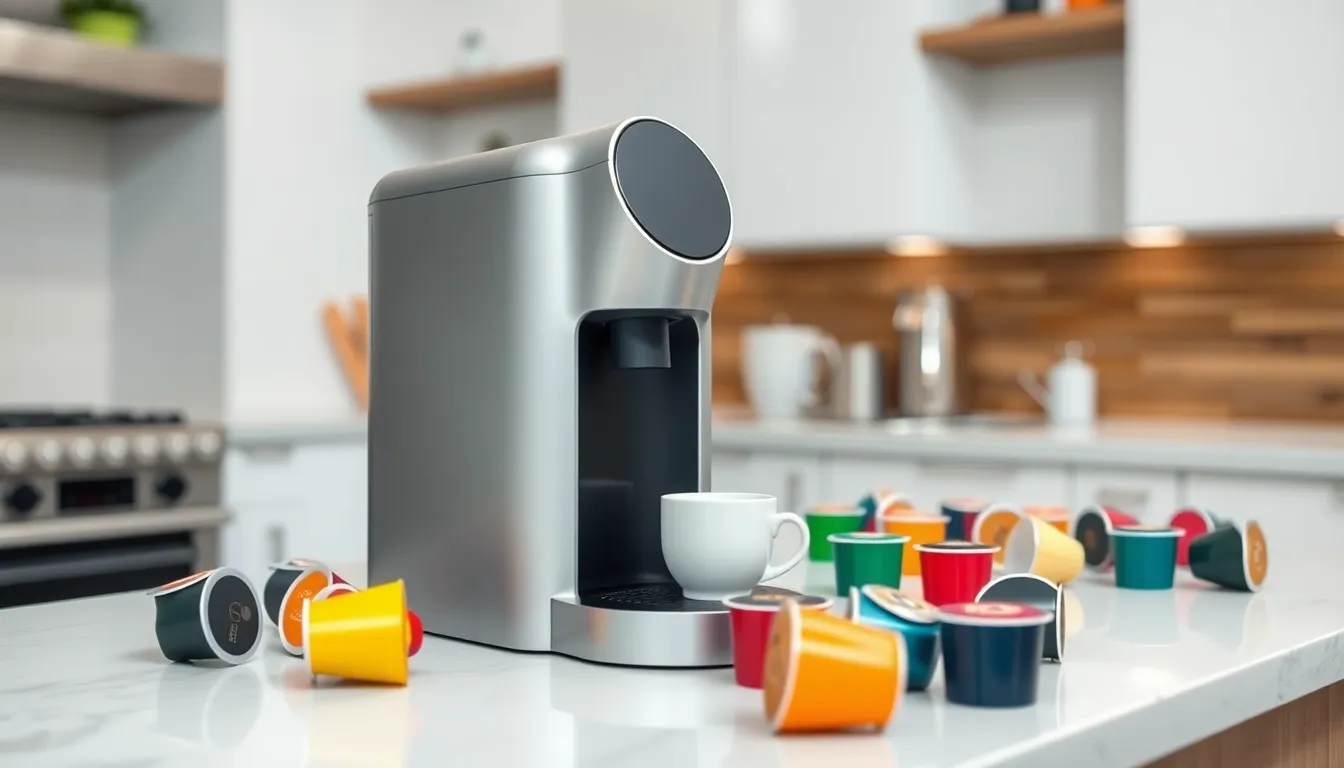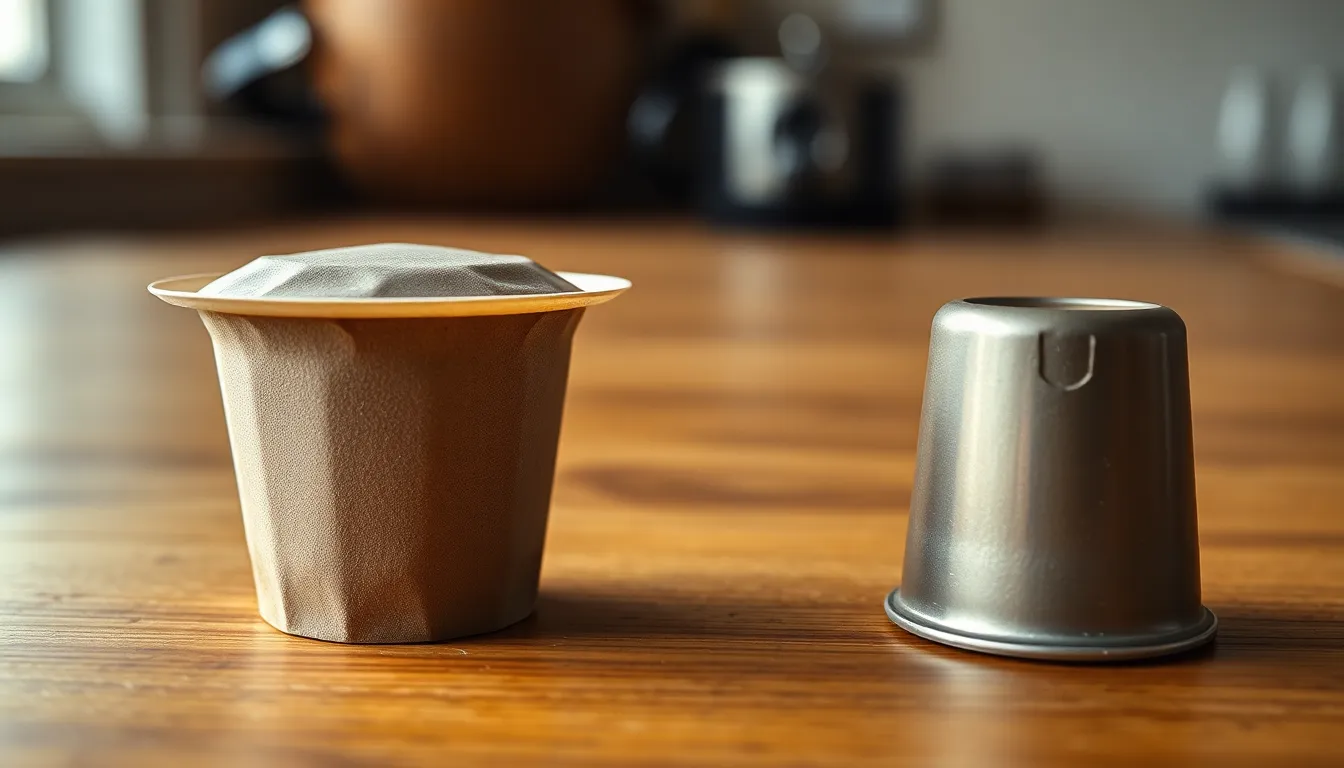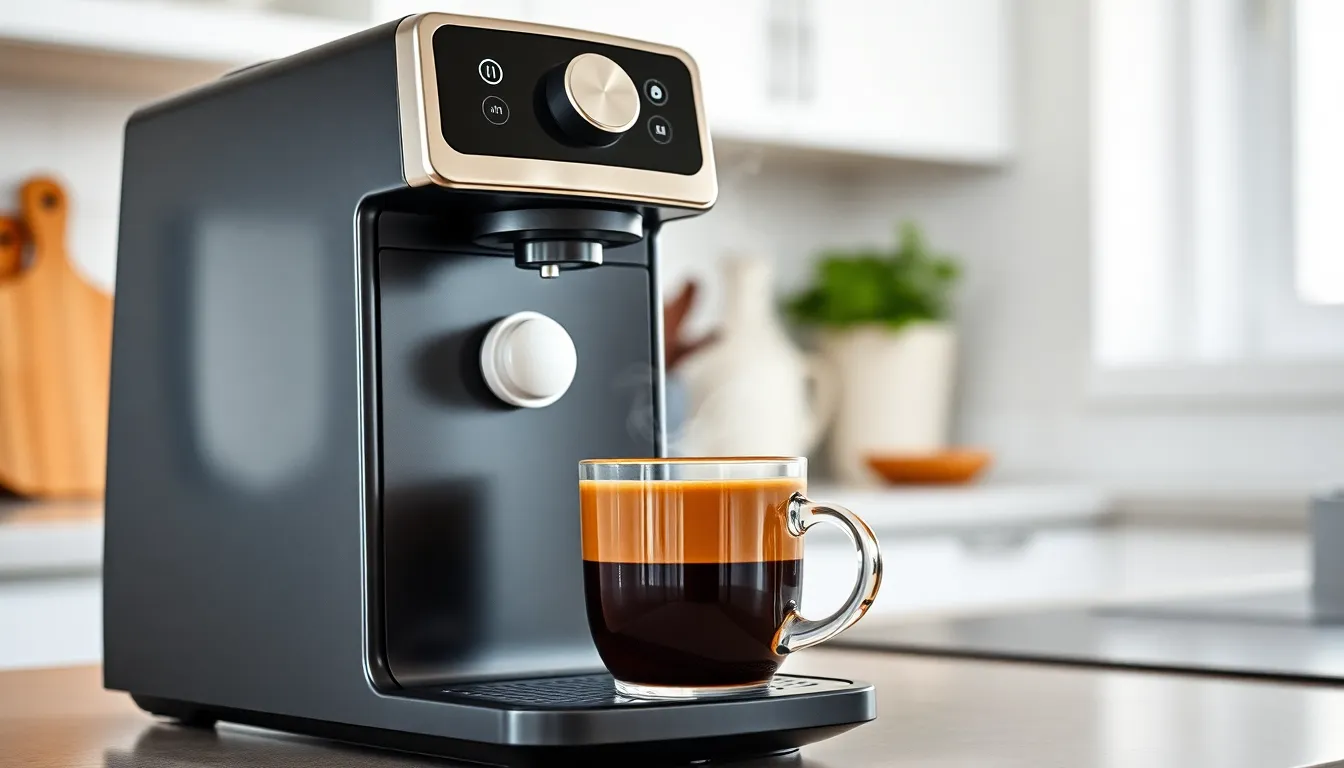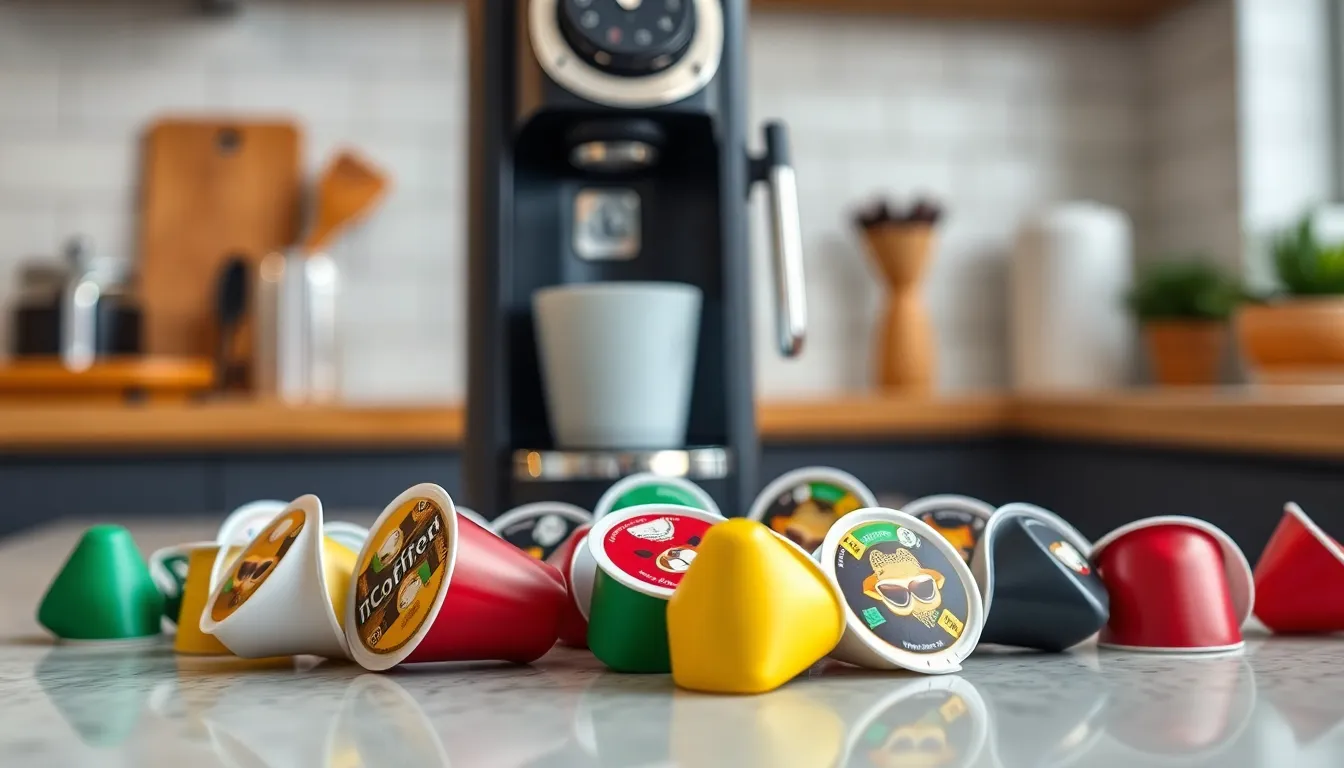What are coffee pods, and why have they revolutionized the way we brew coffee at home? These convenient single-serve packages have transformed morning routines worldwide, offering barista-quality coffee at the touch of a button.
Coffee pods are pre-packaged, single-serving containers filled with precisely measured ground coffee. They’re designed to work with exact coffee machines, eliminating the mess and guesswork of traditional brewing methods. Whether you’re a busy professional racing out the door or a casual coffee drinker who enjoys variety, coffee pods provide a quick, consistent cup without compromising on flavor or quality.
What Are Coffee Pods: A Complete Guide
Coffee pods are self-contained, single-serving packages of pre-ground coffee sealed in individual filter containers. These convenient units come pre-measured and ready to use in compatible coffee machines, eliminating the need for measuring or grinding beans. Each pod contains approximately 7-12 grams of coffee, perfectly portioned for a standard cup.
Unlike traditional brewing methods that require multiple steps, pods offer a streamlined approach to your morning coffee routine. Simply insert the pod into your compatible machine, press a button, and enjoy freshly brewed coffee in under a minute. This hassle-free process has revolutionized home coffee preparation for millions of households worldwide.
Coffee pods differ from coffee capsules in their construction and compatibility. Pods typically feature a round, flat design with coffee grounds sealed between filter papers, while capsules are usually plastic or aluminum containers with coffee sealed inside. Your brewing experience changes significantly depending on which system you choose.
According to Rikki Manny, who’s tested dozens of pod systems, “The simplicity of coffee pods transformed my mornings completely. I’ve gone from spending 10 minutes measuring and preparing coffee to enjoying a perfect cup in just 30 seconds.”
Most coffee pods come in standard 44-62mm sizes compatible with various machines including Senseo, Melitta, and many universal pod brewers. The universality of these pods gives you flexibility when choosing brewing equipment, unlike proprietary capsule systems that lock you into exact machines.
The Evolution of Coffee Brewing

Coffee brewing has transformed dramatically over the decades, from traditional methods to the convenient pod systems popular today. The journey began with simple filter coffee makers and percolators that required measuring ground coffee and changing filters for each brew. These methods, while effective, demanded time and attention from coffee enthusiasts.
The introduction of coffee pods in the early 2000s revolutionized home brewing by offering pre-measured, self-contained units of coffee. The original coffee pod resembled a tea bag – a round, flat, two-sided paper filter filled with ground coffee, primarily used in machines like Senseo. This innovation eliminated the need for measuring coffee or changing filters, making the brewing process significantly more accessible.
As technology advanced, so did coffee pod designs. Soft pods made of filter paper gained popularity for their ability to allow better water flow, producing more flavorful coffee. Though they typically contain less coffee than other formats, their design optimizes extraction for a balanced cup.
Hard pods or capsules emerged as the next evolution – small plastic or aluminum containers hermetically sealed to preserve freshness. These capsules, designed for systems like Nespresso and Keurig, provide remarkable consistency and often contain more coffee or additional ingredients for creating various coffee drinks. Aluminum capsules particularly excel at producing espresso with rich crema in diverse flavors and intensities.
“I’ve seen customers’ morning routines completely transform after switching to pod systems,” notes Rikki Manny. “What used to be a 10-minute process now takes just 30 seconds, and they’re getting consistently good coffee without the mess.”
The most recent development in this evolution is the emergence of compostable and specialty pods. These environmentally conscious alternatives address sustainability concerns while maintaining compatibility with various machines. Some pods are even reusable, catering to different consumer preferences and environmental values.
Coffee pods represent not just a convenience revolution but an evolution in brewing technology that delivers quality, consistency, and variety for coffee lovers. From simple paper pods to sophisticated capsules with multiple ingredients, this brewing method continues to adapt to consumer needs while improving the coffee experience.
Understanding Coffee Pods vs. Coffee Capsules

Coffee pods and coffee capsules represent two distinct approaches to single-serve coffee brewing, each with unique characteristics and requirements. These single-serve options have transformed home brewing, but they’re not interchangeable even though their similar purpose.
Key Differences Between Pods and Capsules
Coffee pods consist of disc-shaped paper shells resembling tea bags that contain approximately 7 grams of ground coffee. Their paper construction makes them biodegradable but limits their shelf life compared to capsules. Capsules, in contrast, are cylindrical containers made from plastic or aluminum that vacuum-seal about 5 grams of coffee, preserving freshness significantly longer.
The material composition creates notable differences in durability and environmental impact. Pods with their paper shells break down more easily, while capsules with plastic or aluminum bodies require exact recycling processes. Shape differences are also functional – pods maintain a flat, round profile while capsules adopt cylindrical forms that vary by manufacturer.
Cost considerations favor pods substantially, with an average price of 18 euro cents per pod compared to over 40 euro cents for capsules. This price difference adds up quickly for daily coffee drinkers, making pods the more economical choice for budget-conscious consumers.
Compatibility With Different Machines
Coffee pods work with machines designed with pod filters or baskets, commonly found in manual or lever coffee machines. These systems place the pod into a filter basket where hot water passes through under pressure. Many pod-compatible machines offer versatility, accepting both pods and traditional ground coffee with simple filter changes.
Capsule systems require specialized machines engineered specifically for their design. These machines puncture the capsule and force pressurized hot water through it for extraction. The proprietary nature of these systems means a Nespresso machine won’t accept Keurig K-cups and vice versa.
Machine compatibility represents a commitment to a exact brewing network. Pod systems typically offer more flexibility with standardized sizes that work across multiple brands. Capsule systems lock users into proprietary formats but often deliver more consistent results due to their precise engineering and vacuum-sealed freshness.
How Coffee Pods Work

Coffee pods function through a precise extraction process that delivers consistent results with minimal effort. When inserted into a compatible machine, the pod is pierced to allow pressurized hot water to flow through the coffee grounds, extracting rich flavors and aromas before flowing into your cup.
The Brewing Process
The coffee pod brewing process follows a simple yet effective sequence:
- Fill your machine’s water tank with fresh, filtered water for optimal taste.
- Turn on the machine and allow it to reach proper temperature, typically indicated by a status light.
- Insert the coffee pod into the designated compartment and secure it closed.
- Your machine automatically pierces the pod’s seal to prepare for extraction.
- Hot water heated to 90–96°C (195–205°F) flows through the pod under pressure.
- This pressurized water extracts coffee oils, flavors, and compounds as it passes through the grounds.
- Freshly brewed coffee flows from the pod directly into your waiting cup.
Each pod creates a single serving of coffee, though coffee enthusiasts sometimes use multiple pods for a stronger brew. The entire process takes less than a minute, transforming what was once a 10-minute ritual into a 30-second convenience, as Rikki Manny discovered during his extensive testing of various pod systems.
Types of Coffee Pod Systems
Coffee pod systems come in several varieties, each with unique characteristics:
- Nespresso-compatible pods operate with machines that pierce the pod and apply pressure to create espresso-style coffee with rich crema. These systems focus on delivering concentrated, full-bodied coffee.
- Capsule machines employ similar technology but emphasize pressure control to produce both espresso and frothy coffee varieties. The pressure causes slight expansion of the pod during brewing, improving extraction quality.
- Soft filter pods contain coffee grounds between biodegradable paper filters, offering an environmentally friendly option with excellent water flow characteristics.
- Hard pods feature more rigid construction to preserve freshness longer and maintain consistency between brews.
Different systems vary in pod size and machine design, but all operate on the fundamental principle of piercing the pod and forcing hot water through under controlled pressure. This standardized approach explains why coffee pods deliver remarkably consistent results, regardless of barista skill level.
Benefits of Using Coffee Pods

Coffee pods transform the home brewing experience by offering several advantages that make them popular among coffee enthusiasts. From saving precious morning minutes to delivering dependable taste, these compact coffee answers address many common brewing challenges.
Convenience and Speed
Coffee pods eliminate the need to measure coffee grounds, providing a quick and effortless brewing solution for your busy lifestyle. You simply insert the pod, press a button, and enjoy freshly brewed coffee in under a minute. This streamlined approach has revolutionized morning routines for millions of households worldwide. Rikki Manny, who has extensively tested many pod systems, notes that coffee pods have dramatically reduced his coffee preparation time from 10 minutes to just 30 seconds, transforming his morning experience.
Consistency in Flavor
Each coffee pod contains precisely measured coffee grounds, ensuring you get the same great taste with every brew. The standardized amount of coffee in each pod—typically 7-12 grams—creates a reliable flavor profile that doesn’t vary based on measuring errors or brewing technique. This consistency makes coffee pods particularly appealing for those who appreciate predictable results without the learning curve of traditional brewing methods. The controlled pressure extraction system delivers remarkably consistent results regardless of your barista skill level, allowing you to enjoy cafe-quality coffee at home without specialized training.
Environmental Impact of Coffee Pods

Coffee pods create important environmental challenges due to their single-use nature and materials. The convenience of pod brewing comes with environmental consequences that many coffee drinkers are increasingly concerned about.
Recycling and Biodegradable Options
Sustainable alternatives to traditional coffee pods have emerged in response to environmental concerns. Compostable coffee pods made from biodegradable materials like filter paper or plant-based plastics break down naturally, reducing landfill waste. These eco-friendly options can typically be disposed of with organic waste, making them a more responsible choice for environmentally conscious consumers.
Recyclable pod options exist but depend heavily on local recycling capabilities. Many municipalities lack the specialized processes needed to separate coffee grounds from pod materials, creating a disconnect between theoretical recyclability and practical waste management. Aluminum pods offer better recycling prospects than plastic varieties, though they still require proper sorting and processing.
Reusable coffee pods represent perhaps the most sustainable solution, allowing you to fill them with your preferred coffee grounds multiple times. This approach dramatically reduces waste while maintaining the convenience of pod brewing systems. Many coffee enthusiasts find that reusable pods provide an ideal balance between environmental responsibility and brewing convenience.
The environmental impact of traditional plastic and aluminum pods is particularly troublesome. These non-biodegradable materials contribute significantly to landfill waste, with the combination of coffee residues and non-recyclable components creating waste management challenges. Hard plastic pods are especially problematic as they often remain intact for hundreds of years after disposal.
Popular Coffee Pod Brands and Varieties

Coffee pod enthusiasts enjoy many options across major brands and specialty producers. Origin Specialty Coffee Pods offers a distinctive House Espresso featuring chocolate, nuts, and caramel notes that satisfy discriminating palates. Their Decaf pods, sourced directly from Nicaragua, deliver unique Assam tea, red apple, and chocolate tasting notes while remaining compatible with Nespresso machines (excluding Vertuo models).
Keurig K-Cups dominate the hard pod market with their extensive flavor selection, designed specifically for Keurig brewing systems. These pods create a convenient brewing experience with consistent results across their wide variety of coffee blends and flavors.
Nespresso Pods, made from aluminum, produce espresso-level coffee with rich crema and intensity. Their airtight design preserves freshness and ensures consistent quality with each brew, making them popular among espresso lovers seeking convenience without sacrificing quality.
Environmentally conscious coffee drinkers gravitate toward compostable pods made from biodegradable materials. These eco-friendly alternatives reduce environmental impact while still delivering excellent coffee flavor, addressing sustainability concerns without compromising taste.
Additional pod options include one-cup filter pods for traditional drip-style coffee, cold brew pitcher packs for refrigerated preparation, and reusable pods that accommodate your personal coffee selection. Each pod type serves different preferences and machine compatibilities, giving you flexibility based on your brewing system and taste preferences.
Cost Comparison: Coffee Pods vs. Traditional Brewing

Coffee pods offer convenience at a premium price compared to traditional brewing methods. The cost difference stems from several factors, including packaging, technology, and the coffee itself.
Hard pods (capsules) typically cost more than soft pods due to their hermetically sealed design and specialized production process. A single hard pod like those from Nespresso or Keurig can range from 40+ euro cents per serving, while soft pods average around 18 euro cents each.
Traditional brewing methods using ground coffee or beans prove more economical for daily consumption. Purchasing coffee in bulk significantly reduces the per-cup cost compared to individual pods. Many coffee enthusiasts find this cost difference substantial when calculating their monthly coffee expenses.
The true value equation isn’t just about the direct cost per cup. Coffee pods eliminate waste from unused grounds and reduce cleanup time. They also provide consistent quality with each brew, regardless of your barista skills. These convenience factors may justify the higher price point for many consumers.
Environmental costs also factor into the comparison. Soft pods made from filter paper are generally compostable, making them more eco-friendly than plastic or aluminum capsules. Traditional brewing creates minimal packaging waste but may use more water during cleanup.
Your brewing frequency and lifestyle preferences eventually determine which method provides better value. For occasional coffee drinkers who prioritize convenience and consistency, pods may justify their premium. Regular coffee enthusiasts who enjoy the brewing process might find traditional methods more cost-effective and satisfying over time.
Conclusion
Coffee pods have revolutionized home brewing by offering convenience without sacrificing quality. They’ve transformed a time-consuming morning ritual into a 30-second experience that delivers consistent results every time.
Whether you choose soft biodegradable pods or aluminum capsules depends on your priorities about cost sustainability and machine compatibility. The higher price point compared to traditional brewing methods reflects the value of time saved and elimination of waste.
As the market evolves more environmentally friendly options continue to emerge addressing the biggest criticism of pod systems. Your perfect brewing solution eventually depends on your lifestyle coffee consumption frequency and environmental values.
Coffee pods aren’t just a trend—they represent a important advancement in how we enjoy our daily caffeine fix at home with barista-quality results.
Frequently Asked Questions
What are coffee pods and how do they work?
Coffee pods are self-contained, single-serving packages of pre-measured ground coffee designed for specific machines. When inserted into a compatible coffee maker, the pod is pierced to allow pressurized hot water to flow through the coffee grounds. This extraction process delivers consistent results with minimal effort, brewing fresh coffee in under a minute without measuring or grinding beans.
What’s the difference between coffee pods and coffee capsules?
Coffee pods are typically round, flat packages with coffee grounds sealed between filter papers, often biodegradable and more economical (averaging 18 euro cents per pod). Capsules are usually made of plastic or aluminum, have a longer shelf life, cost more (over 40 euro cents each), and require proprietary machines. Pods offer greater machine compatibility, while capsules are designed for specific systems.
How much coffee is in a typical coffee pod?
A typical coffee pod contains approximately 7-12 grams of coffee, which is precisely measured and perfectly portioned for brewing a standard cup of coffee. This consistent amount eliminates the need for measuring and ensures a reliable flavor profile with every brew.
Are coffee pods environmentally friendly?
Traditional coffee pods pose environmental challenges due to their single-use nature. However, sustainable alternatives are emerging, including compostable pods made from biodegradable materials and recyclable options. Reusable coffee pods offer the most eco-friendly solution, allowing multiple uses and significantly reducing waste compared to conventional plastic or aluminum pods.
How much time do coffee pods save compared to traditional brewing?
Coffee pods dramatically reduce brewing time. According to expert Rikki Manny, they transform coffee preparation from a 10-minute process to just 30 seconds. The pre-measured, self-contained design eliminates grinding, measuring, and extensive cleanup, making it ideal for busy mornings or quick coffee breaks.
What are the most popular types of coffee pod systems?
Popular coffee pod systems include Nespresso-compatible pods (aluminum capsules for espresso-style coffee), Keurig K-Cups (dominant in the hard pod market), soft filter pods (compatible with various machines), and specialty options like Origin Specialty Coffee Pods. Each system offers unique characteristics while operating on the same principle of controlled pressure extraction.
Are coffee pods more expensive than traditional coffee brewing?
Yes, coffee pods typically cost more per serving than traditional brewing methods. Hard pods (Nespresso/Keurig) can cost over 40 euro cents per cup, while soft pods average around 18 euro cents. Traditional ground coffee is more economical, especially when purchased in bulk. However, pods eliminate waste from unused grounds and reduce cleanup time, which some consider worth the premium.
Can I use any coffee pod with my machine?
Most coffee pods come in standard sizes compatible with various machines, but compatibility depends on your specific coffee maker. Soft pods offer greater flexibility across different machines, while capsule systems require proprietary equipment designed for their specific shape and size. Always check your machine’s requirements before purchasing pods.

